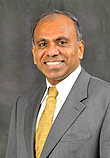Remarks

Dr. Subra Suresh
Director
National Science Foundation
Biography
Welcoming Remarks
at the Council on Undergraduate Research and
National Conferences on Undergraduate Research
Library of Congress
October 27, 2010
Photo by Sandy Schaeffer
Thank you, Nancy [Hensel], for that warm welcome and kind introduction. Actually, Nancy, I am not as new to NSF as you stated, as I started there not this past Monday but Monday a week ago.
I am glad to be here. This milestone meeting of your two organizations, the Council on Undergraduate Research and the National Conferences on Undergraduate Research, combines your forces into one unified, and I suspect, powerful voice.
I especially look forward to working with your community in my new position as Director of NSF. You are a very important part of the NSF mission.
For over 200 years, the United States has been the land of opportunity. I know, and that is why I came to the United States.
That was quite a few years ago. Since then, many events and trends have changed the global picture and this, in turn, has changed many aspects of our collective lives. Among them has been the education enterprise in the U.S. and particularly the undergraduate STEM education enterprise, which is of immediate concern to all of us here today. Many of these changes are positive. Some are negative. To name a few of those trends:
- Demographic shifts in the U.S. undergraduate population and the dynamic shift projected for the nation by 2050, or near then, make our country's population a majority of minorities.
- The need to encourage and assist this growing quadrant of our population to enter STEM disciplines will be a key factor.
- The huge increases in tuition relative to middle and lower income families' assets. I know, because I have two daughters in college; one is in medical school.
- The pressure to acquire ever higher levels of education in order to compete with the knowledge and skills of students in the emerging group of international competitors who have a more intense hunger for science and technology than our students do.
- The recent and historic shift toward a higher percentage of female undergraduate students.
On the negative side of these trends:
- The insufficient skills and competencies of U.S. students for success in a knowledge-based society.
There are other factors:
- The rapid pace of change. Changes of jobs. Younger people today will need to relocate and change jobs and careers more than their parents or grandparents had to, as a result of the changing globalized workforce.
To my mind, two of these trends bode ill for our future: the insufficiency of U.S. student skills to compete and the growing costs of education.
The other trends have advantageous potential if we make the right responses and decisions.
Of systemic change, we will see an increasing number of undergraduates attending 'virtual schools' to earn degrees. We can argue as to whether this is a positive or a negative. In addition, we are witnessing the steady expansion of community colleges as an option for high school graduates. They offer lower tuition rates and a growing set of educational options. Community colleges are an important part of NSF's portfolio of support and are one of the President's priority issues in STEM education.
In the more extreme possibility range -- the day may come when online undergraduate education is the norm. Bricks-and-mortar campuses may come to house primarily graduate schools and administrative functions. Is that a good thing? And, how good is that? We will see.
Although this is currently hard to imagine, the important issue is that your organization, along with NSF and other important constituencies have a very strong voice in the long-term value of any decisions.
Let me mention some statistics to show the power of undergraduate research at MIT. There is no compulsory requirement for undergraduates to do research. But, in four years, 85 percent of undergraduates do at least one semester of professional research, and many file for patents, and many start companies. This fires up students and it drives the pace of MIT.
Of deep concern is that undergraduate STEM education has a vital hands-on-learning component that is critical to professional expertise. You will provide an important voice in these discussions and decisions.
I don't simply represent NSF; as Nancy alluded to, I can also speak from the heart. MIT worked with many of these undergraduates.
We all know that educational requirements have expanded for increasing numbers and categories of jobs. Part of this is the result of increased job market competition but also because many jobs by the same name have become more complex and require further education.
In this audience, I think I would find major agreement that if research is integral to the professional activities of scientists, then we cannot countenance a continuing polarization between research and teaching.
In my previous job duties, I did teaching evaluations of 375 teachers. Some of the best teachers do both teaching and research.
To borrow phrasing from your own community: "In undergraduate research, teaching and scholarship become parts of one simultaneous, overlapping, shared process."
NSF has been a strong advocate of undergraduate research in helping to diversify and sustain the integrity of the science career pipeline in the United States.
I will need your help to advance the idea that inquiry-based learning, scholarship, and creative accomplishments foster high-level learning by undergraduate students. This movement can help to catalyze a needed sea change in undergraduate STEM education.
I look forward to working with all of you to accomplish the nations goals. Thank you again for including me in this important occasion.


